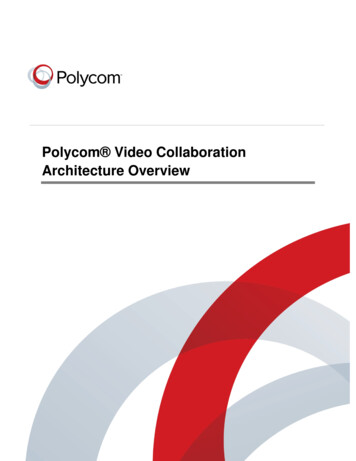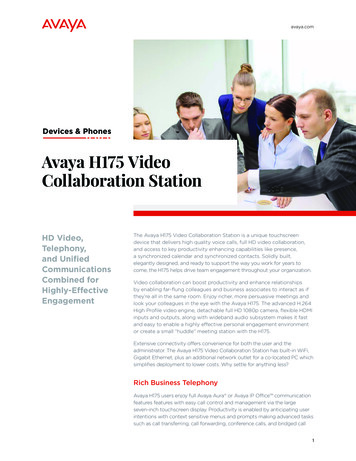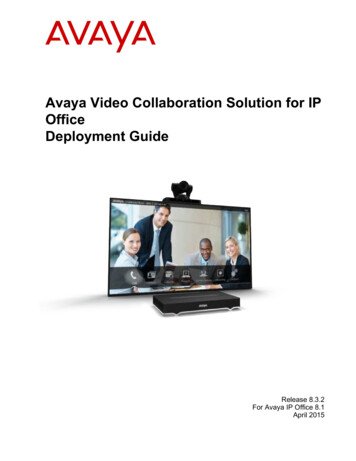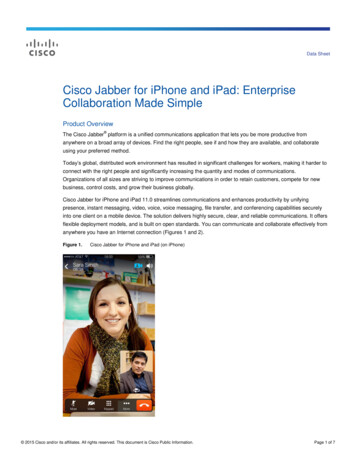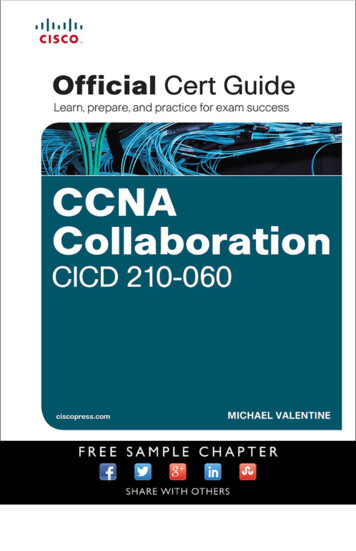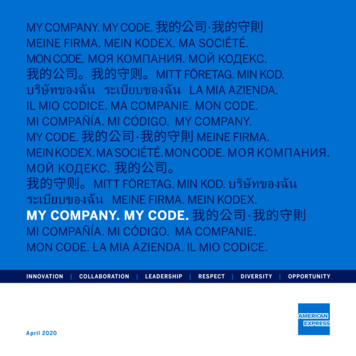
Transcription
EnterpriseVideoCollaborationDavid & Goliath Stories1Cisco vs. Polycom,Pexip and Acano
Table of ContentsIntroduction . . . . . . . . . . . . . . . . . 3Ch 1: Polycom . . . . . . . . . . . . . . . . 4Ch 2: Pexip . . . . . . . . . . . . . . . . . . 9Ch 3: Acano . . . . . . . . . . . . . . . . .14Ch 4: Cisco Fights Back . . . . . . . . . . 18Conclusion . . . . . . . . . . . . . . . . . .232
IntroductionWe’ve been watching what’s going on in the collaboration space forquite a while now and we’ve seen our fair share of battles betweencollaboration technology vendors.Organizations like Polycom, Cisco, Pexip and Acano, have all thrown astone or two in the battle for collaboration excellence, but there is anobvious “David & Goliath” pattern that is hard not to notice. Cisco is“Goliath” in every story, but each “David” has a unique way of attackingthe big guy. In this ebook, we tell the collaboration industry versionof David and Goliath by explaining how each “battle” impacts theworkplaces of the future.Read on to learn how these battles will influence the way you design /build your enterprise video collaboration network.3
Polycom4
Stone #1Deep Skype for Business IntegrationRemember using Cisco’s software client Cisco Jabber? It’s okay if youdon’t. The product represents Cisco’s attempt to compete with thepervasive Microsoft Lync client (now Skype for Business). The productultimately never really threatened Skype for Business for marketdominance. However, it did create a distraction that gave Polycom animportant opportunity to sneak up and throw a stone at Goliath (Cisco).While Cisco was competing with Microsoft’s product for market sharein the unified communications space, Polycom partnered with Microsoftand secured a future of integrated products unlike any others in thevideo collaboration space.5
ContinuedDeep Skype for Business IntegrationIn 2013, Microsoft announced the Microsoft Lync Room Systemconcept, and four exclusive video conferencing partnerships withvendors including Polycom.What makes Polycom’s integration with Skype for Business differentfrom others in the space is their native support of Microsoft’sproprietary real-time communication endpoints and RMX bridges,which eliminates the need for 3rd party gateways. Polycom now boasts“direct integration with over 40 voice, video, and content solutions thatintegrate with Skype for Business, Microsoft Lync, SharePoint, Exchangeand Office 365.”Score 1 for Polycom.6
Stone #2Lower Cost / High QualityVideo TechnologyPolycom, like a number of other video vendors, competes with Ciscofor video collaboration endpoint and infrastructure sales. You couldsay Polycom is to Cisco as Honda is to Mercedes. Mercedes makes veryhigh quality, expensive cars with all of the bells and whistles. Hondacompetes with Mercedes by selling high quality cars with fewer bellsand whistles, at a lower price.polycomciscoSome might argue that Cisco telepresence delivers the highestquality video collaboration experience (innovators in 1080p and 4Kvideo resolution quality), but bandwidth constraints and high upfrontcosts are BIG concerns in the enterprise videoconferencing market.Cisco does offer lower budget collaboration options, but Polycom’sRealPresence product line is priced lower with comparable qualitymaking them a highly scalable and cost effective option for enterprise.7
Stone #3Conference Room Phoneswith Video AttachmentsPolycom has long been a leader in the market for audio conferencephones which creates a large upsell opportunity as many organizationslook to outfit their huddle rooms with video. In 2015, Polycom launchedthe RealPresence Trio system to capitalize on this opportunity.The RealPresence Trio is a room system with powerful three-partcollaboration capabilities: voice, video and content - and smoothinteroperability with Skype for Business. The hub concept is the first ofits kind - a Polycom audio conference phone with visual communicationand content sharing capabilities. This could be a game changer forhuddle room video deployments.8
Pexip9
Stone #1Introducing Scalabilitywith Software-Based MCUPexip was founded by a group of innovative minds from variousbackgrounds in video conferencing including organizations like Ciscoand Tandberg. Before Pexip, MCUs were expensive and inflexible soorganization’s would often over buy or under buy license capacity.So in 2013, the Norwegian video vendor launched a new virtualizedcollaboration bridge with flexible scalability for large enterprises.The goal of the product is to provide multiple users across ageographically dispersed organization with personal VMRs that includemulti-protocol support (SIP, H.323, Microsoft-SIP, WebRTC, RTMP),desktop client support (Windows, OSX, Linux) and mobile support (iOSand Android).10
ContinuedIntroducing Scalabilitywith Software Based MCUPexip Infinity has a virtual software architecture that is distributed,so any number of conferencing nodes can be distributed acrossany number of geographic locations managed by the same singlemanagement node. In addition to scalability, an all-software solutionreduces the complexity and cost of deployment - another big deal forcustomers.“The cost of Infinity will be up to 80% less than the cost of hardwareMCUs and Pexip claims that organizations are paying for Infinity aboutwhat they would pay for just the annual maintenance on a hardwareMCU alone.”With lower costs and flexible scalability Pexip’s first stone hit Goliathwhere it hurts!Source: he-infinity-video-mcu11
Stone #2Flexible Skype forBusiness IntegrationAt this point, almost all of Cisco’s competitors in the enterprisecollaboration space offer interoperability with Skype for Business, butPexip has a uniquely flexible deployment for single data centers orgeographically dispersed S4B deployments.In the instance of an organization with globally dispersed Skypefor Business clients, S4B servers are configured for each locationto support dialing out from a conference to a Skype for Businessparticipant. This allows Pexip Infinity to dial out to the server from aConferencing Node at the most appropriate geographic location,enabling the shortest path and most efficient media routing option.12
Stone #3Lower Video CollaborationBandwidth CostsPexip bridging technology enables lower video collaborationbandwidth costs than Goliath (Cisco). Deployments with a widegeographic dispersion can reduce network bandwidth usage andstill keep a high quality audio / visual experience even on multipointcalls. Rather than stacking Pexip VMRs in a single data center, Pexipconference nodes can be distributed as appropriate, so that meetingscan be dialed into using the closest available conference node.“Pexip Infinity’s distributed architecture can reduce conferencebandwidth usage by up to 90%”New YorkPexip Infinity’sdistributed architecture canREDUCE CONFERENCEBANDWIDTH USAGE90%byup to13LondonCape Town
acano14
Stone #1The New PersistentCollaboration Meeting RoomFrom its inception, Acano came out chucking stones at the big guy. Thecompany was founded in 2012 by former C-level execs at Cisco andTandberg. Acano’s Tandberg heritage brought an exceptional blend ofproduct knowledge as well as a network of channel partners and solidsales teams for its go-to-market strategy.The first stone thrown came in the form of a product unlike any otherat the time. Acano introduced a “persistent meeting room” conceptthat they called an Acano Cospace. This virtual meeting room blurredthe lines of the traditional video conferencing and audio conferencingbridges - designed as a team collaboration space with audio and videocapabilities. It isn’t an audio conferencing bridge, video MCU, or webconferencing server, but a combination of all three.The big guy (Cisco) did not offer any type of virtual bridge hybridcomparable to the Cospace at the time of it’s announcement.Boom.15
Stone #2Skype for Business IntegrationBefore Acano, IT administrators were frustrated with calls from usersabout Lync/Skype for Business clients not being able to dial into videoconference room bridges and vice versa, but the Cospace changed that.With Acano’s announcement of its “dual home” offering in 2015, theCospace solution further solidified the integration by bringing togetherstandards-based videoconferencing systems and S4B without any UIuser experience changes or reduced functionality for participants usingtheir S4B clients. To this day Cisco does not offer anything close. Acano’s“dual home” technology played a part in turning Cisco’s attention to theUK startup and helped put the official acquisition plans in motion.Video16 Audio Content IM more
Stone #3Radically Lower AudioConferencing CostsThe Cospace was originally designed to be a better solution for videoconferencing. However, they discovered many organizations usedCospaces for audio conference meetings. The solution has the capacityfor up to 10,000 simultaneous audio calls on a single 2U server.According to Wainhouse Research, “By the middle of Y2015, audiorepresented 5-10% of Acano’s total revenues.”BY THE MIDDLE OF Y2015,AUDIO REPRESENTED5 - 10%OF ACANO’S TOTAL REVENUES17
Ciscofights back18
The misunderstood beast finally had enough of being pelted withstones, and fought back by throwing a few boulders back at the“would be” Davids.Boulder #1Cisco Acquires AcanoOne of this biggest moves as of late was Cisco’s acquisition of Acano.Cisco has acquired over 12 organizations in the collaboration space inthe last ten years, but this one was particularly special for a couple ofkey reasons:Acano’s flexible bridge gives Cisco S4B integration(an answer to Polycom and Pexip).Cisco can leverage Acano’s unique technology advantages(e.g., persistent Cospaces, low cost/scalable audio conferencing).Cisco removed a major disruptor in the collaboration space.19
Boulder #2 Cisco SparkAnother boulder Cisco is throwing is their new Spark product. Theambitious product is Cisco’s entry into the enterprise cloud audio,video, messaging, persistent meeting room, and the collaboration APImarkets. Cisco will be competing with many players including Slack,Twilio, and a whole host of unified communications as a service (UCaaS)providers. According to Wainhouse, Cisco’s Rowan Trollope wantsto build the best-in-class real time communications platform for theenterprise.“If you want commodity productivity solutions - email, documents,spreadsheets, online storage - give Microsoft or Google a call. Butwhen you need a real-time communications platform you can counton, come to Cisco. And we’re happy to integrate with other providers’asynchronous solutions when and where it makes lans20
ContinuedCisco SparkCisco is explicitly targeting the enterprise with Spark through its pricingmodel, history of industry-leading call quality, and an API model tobuild up an ecosystem of partners. You can bet Cisco will capitalize onits relationships in the enterprise to support Spark’s expansion whichwill put all of the would be Davids on their heels.Bam.21
Boulder #3 Cisco WebExCisco already has 90% of Fortune 500 companies in its WebEx installedbase, and continues to improve WebEx’s collaboration capabilities.With CMRs, users can now can easily join WebEx meetings from anystandards-based room system. This will be a huge feature as morelarge organizations begin to video-enable huddle rooms. Even with thegrowing popularity of Skype for Business in the enterprise WebEx is stillrelevant and sticky. In a 2015 Wainhouse report, 2H 2015 WebMetrics,21% of panelists use Skype for Business (or Lync) for their day-to-dayweb conferencing solution vs. 34% who use WebEx.22
ConclusionThe enterprise video collaboration wars will rage on for many years tocome. In this eBook we have not addressed the other Goliath in the space- Microsoft - who will also affect how enterprises optimize their unifiedcollaboration networks. But based on the David and Goliath storiescovered in this document we have picked four key trends to keep in mindas you plan and make investments in your network:Skype for Business (S4B) integration and interoperability is critical tomaximize the potential of video collaboration and take advantage of themillions of S4B enabled PCs and devices.VMRs and team meeting spaces will be key features in a workplace ofthe future. Vendors that can make meeting in a “video meeting room” aseasy as entering a physical conference room will make users happy, moreproductive, and drive much greater usage.Technologies with lower video collaboration bandwidth requirementswill keep costs under control and improve user experience when networkbandwidth is stressed.Arming huddle and traditional conference rooms with videoconferencing endpoints will be the next great innovation to make videocollaboration mainstream in the enterprise.23
Winning the War with AnalyticsImprove user experience and optimize your videocollaboration network with Vyopta’s vAnalytics.A single system to monitor, support, and optimize collaboration networksacross large organizations.Improve user experience by detecting and resolving problems faster withreal time monitoring and video call quality alerts.Use historical analytics to improve network efficiency with better capacityplanning and endpoint/ infrastructure allocation.Accelerate adoption with actionable insights by tracking usageacross your entire organization or custom groups (e.g., businessunits, geographies).Get a Demo of vAnalytics24
Cisco does offer lower budget collaboration options, but Polycom’s RealPresence product line is priced lower with comparable quality making them a highly scalable and cost effective option for enterprise. Lower Cost / High Quality Video Technology 7 polycom cisco
